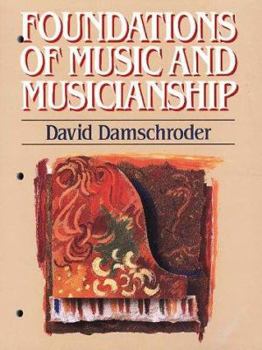Foundations of Music & Musicianship
Select Format
Select Condition 
Book Overview
Be an active participant in the learning process with FOUNDATIONS OF MUSIC AND MUSICIANSHIP with accompanying CD-ROM The many activities in this book, along with the accompanying CD-ROM, will help you... This description may be from another edition of this product.
Format:Hardcover
Language:English
ISBN:0028706617
ISBN13:9780028706610
Release Date:February 1992
Publisher:Schirmer
Length:479 Pages
Weight:2.55 lbs.
Dimensions:1.0" x 8.4" x 10.9"
Customer Reviews
2 ratings
A fine text to begin learning the grammar of music
Published by Thriftbooks.com User , 20 years ago
What a fabulous resource for an introductory course in music! The book is aimed at liberal arts students who want to take a course in the fundamentals of music, however, I think (way) back to my music theory course in high school and this would have been a terrific text for that kind of course as well. Since music making is an activity that involves your mind (and heart), I appreciate Prof. Damschroder's emphasis on learning through doing. Students will sing, clap, and play their way to understanding the basic grammar of music. The text starts at the very beginning of musical notation and works its way through rhythm, meter, scales, accidentals, chords, and some chromaticiscm. By the end of this one term course the student understands the basics of harmonizing simple melodies and can detect errors in notation and matching what they hear with what is written down. There is a good basic glossary and an appendix with additional musical notation helps. An index is also provided.Another terrific resource is a CD that contains the musical examples and exercises in the book so the student can work on his or her own and drill themselves a bit and actually work the problems in the book while listening to the exercises through their computer. I like the fact that the student can choose to hear the examples and exercises as a piano, violin, clarinet, oboe, horn, or saxophone if there are pitches. If they are rhythm exercises they can listen to them as a piano, harp, clarinet, vibraphone, drum, or woodblock. It may seem a little thing, but having taught ear training, it does help students to hear examples in the sound they are more familiar in hearing. String players hear strings more easily, woodwind players like to hear woodwinds, and so forth.The book also comes with a large fold out chart of the keyboard with each key diagrammed to its exact place on the bass or treble clef. This can be of immeasurable help to non-keyboard players trying to get oriented to reading two staves as a single unit and how they map onto those white and black keys.This is a real achievement and I hope it gets widely adopted. It certainly can help students in classes, but it is so well done that someone who was interested in learning this material could work through it on their own with the CD. It might help them to have someone they can go to for help now and again, but things are explained quite well in this book.Oh, and when you first try to use the CD, make sure you go to the preferences FIRST and select the proper output mode for your computer.
Attention High School Music Theory Teachers...
Published by Thriftbooks.com User , 24 years ago
Text is well sequenced with content as well as supporting worksheets. There is no irrelevant information in this book to the subject area of Music Theory, as compared to other books which include impertinent information.






